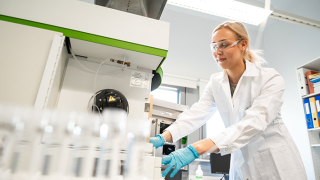Dissertation: Chemical reaction mechanisms and molecular properties revealed through computational modelling (Valjus)

Chemical reactions transform substances into new ones and are often accompanied by changes that can be observed with the naked eye. For example, when wood burns, a series of chemical reactions takes place that produces heat and light as well as gaseous and solid products. But what exactly happens in a chemical reaction at the molecular level? In other words, how do the reacting substances transform into new products by breaking and forming chemical bonds?
- This question is often impossible to answer solely through sensory observations. And studying the mechanisms of chemical reactions is not always easy or possible even when using modern experimental analysis methods, says doctoral researcher Juuso Valjus from the University of Jyväskylä.
Computers can predict how molecules will behave
Over the past 30 years, computational modelling, that is, the study of chemistry using computer simulations, has become an important tool in the study of chemical reaction mechanisms. The accuracy of high-level computational methods combined with the computing power of modern processors allows the energy landscapes, called potential energy surfaces, of chemical species to be calculated with unprecedented accuracy. This makes it possible to explain and predict the reactivity of molecules.
- The potential energy surface can be thought of as a hilly landscape with valleys, mountain passes, and hilltops. The valleys correspond to the permanent shapes of the molecules, and the mountain passes connecting them, in turn, describe the different ways in which the molecules can react and transform into each other, explains Valjus.
The reactive world of phosphinidene chalcogenides
The focus of the actual research work was on phosphinidene chalcogenides that are molecules with a terminal moiety containing a double bond between a phosphorus and a chalcogen atom, either sulfur or selenium. Such a chemical environment makes the molecules highly reactive, and they easily combine with each other to form larger ring structures.
- In my dissertation, I investigated the mechanisms for the formation of various phosphinidene chalcogenide rings along with the reverse reactions for their opening using heat, a base, or a trapping agent. The results allowed us to design new possible reaction pathways through which our collaborators could make increasingly larger and more complex compounds, says Valjus.
Modern methods are leading to a more detailed understanding of chemistry
In addition to phosphinidene chalcogenides, the doctoral thesis of Valjus deals with triatomic negatively charged ions, or anions, formed by nitrogen, oxygen, and sulfur.
- It was surprising to notice that there were very little experimental or computational data on some very simple chemical systems. Furthermore, some of the most recent studies had been conducted several decades ago, utilizing computational methods that are significantly less accurate than those available today, says Valjus.
In one of the sub-publications of his thesis, Valjus used modern computational methods to determine the structures and properties of the ions that were the subject of this study. The results allowed, for example, to formulate a method for how the ion NS2− could be prepared and isolated for analysis.
- So far, only a few indirect observations of this ion have been reported. In addition, previous computational data on its properties were partly contradictory. In contrast, the results obtained in my work give a very consistent picture of the properties and chemistry of NS2−, and I believe that its synthesis will someday be successful, hopes Valjus.
The doctoral research has received funding from the European Research Council (ERC) within the framework of the European Union's Horizon 2020 research and innovation program. The research has also been co-funded by the University of Jyväskylä.
The examination of the doctoral thesis of MSc Juuso Valjus "Computational Modelling of Electronic Structures and Reactivity of Phosphinidene Chalcogenides and Triatomic Anions of Nitrogen, Oxygen, and Sulfur" will be held on the 5th of December 2025 at 12:00 noon in the lecture hall KEM4 of the Department of Chemistry. The opponent is Professor Theo Kurten (University of Helsinki) and the custos is Professor Heikki M. Tuononen (University of Jyväskylä). The language of the defence is Finnish.
The dissertation has been published as part of the JYU Dissertations series of the University of Jyväskylä and is available at https://jyx.jyu.fi/jyx/Record/jyx_123456789_106315?sid=230694250







